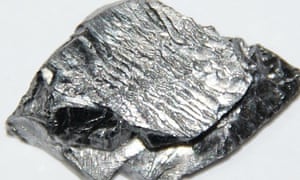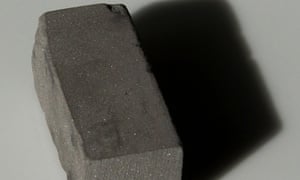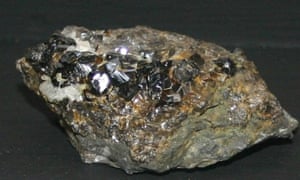The illegal trade of tantalum, tungsten, tin and gold from the Democratic Republic of Congo (DRC) and surrounding countries is fueling conflict in central Africa. Sales of these conflict minerals help fund arms for militias, ultimately leading to human rights abuses. Meanwhile, US companies that use these metals are facing growing pressure to find sources that are conflict-free. An Securities and Exchange Commission rule, scheduled to take effect June 2, would require the vast majority of US companies to disclose whether they use conflict minerals from the region.
Now the SEC rule has come under fire: A US appeals court last week ruled that part of the regulation – a provision requiring companies to state whether their products use conflict minerals – is unconstitutional. Some lawmakers are urging the SEC to move forward with the rest of the disclosure rule, but it's unclear how the commission will proceed, and ongoing litigation adds to the uncertainty about exactly how the conflict minerals rule will take effect.
The good news for companies is that compliance with these new regulations just got easier. In January, the Conflict Free Sourcing Initiative (CFSI) announced the existence of certified conflict-free smelters for all four of the conflict minerals. A key step in the supply chain, smelters turn rocks into purified metals for use in electronics. Tungsten was the last of the minerals to gain a verified smelter, and more smelters are expected in the coming months. As of 3 April, there were nearly 80 conflict-free smelters.
Some big name companies are taking their efforts a step further. Apple has started publicizing which of its suppliers may be sourcing minerals from conflict zones. The first list showed 104 smelters that were not yet verified as safe. The company also has vowed to go completely conflict-free by the end of 2014, meaning that all of its minerals will come from verifiable sources. Intel also recently announced that all of its microprocessors released in 2014 will be conflict-free.
Conflict minerals 101
Tantalum
Tantalum is a crucial ingredient in electronics manufacturing. In fact, half of all mined tantalum goes into electronics, and it is found in almost all electronic equipment, including mobile phones, laptops and hard drives. It is also used on an industrial scale, in jet engines, ships and missiles.
Tantalum can hold the highest electrical charge of any metal, which makes it an ideal component for a device called a capacitor, which stores and releases an electric charge. An average mobile phone only contains about 40mg of tantalum – a relatively insignificant amount, until one considers the hundreds of millions of devices in use.
According to the SEC, central Africa accounts for 15-20% of the world's tantalum supply, although some reports put the figure closer to 50%. The richest deposits of coltan, the naturally-occurring ore that tantalum is extracted from, are found in eastern Congo, where mining is done by hand.
In 2012, tantalum became the first mineral to gain a conflict-free smelter. And, according to the CFSI database, there are currently 26 conflict-free tantalum smelters, located predominantly in China and the US.
For an electronics company looking to clean up its supply chain, tracing its tantalum is a good place to start. Apple, for instance, focused its initial supply chain cleanup efforts on tantalum, and announced in February 2014 that all of its tantalum smelters were validated as conflict-free.
"Tantalum is the one that has the biggest impact because it's in so many electronics," said Jess Kraus, chief executive of Source Intelligence, a company that helps businesses improve the transparency of their suppliers.
Tantalum is also the easiest to trace, because it is used in "very specific circumstances", Kraus said. By comparison, tin is "found in almost everything", from cellphones to toothpaste to pipes.
Tungsten
Tungsten, which is largely derived from wolframite or scheelite, has the highest melting point of any pure metal. Its conductivity, meaning its ability to hold an electric charge, makes it attractive to electronics manufacturers. Along with gold, it is commonly used to make computer chips.
However, only very small amounts of tungsten are used in electronics, which may be the reason that it was the last mineral to acquire a conflict-free smelter. "Tungsten is not as widely used as tin or tantalum or even gold," said Sasha Lezhnev, a senior policy analyst at the Enough Project, a non-profit organization that monitors conflict around the world.
More than 80% of tungsten ore comes from China; by comparison, Africa produces only about 1% of the world's supply. And the DRC's share is even smaller: According to the US Geological Survey, it was only responsible for around 0.5% of the world's supply in 2009.
The first conflict-free tungsten smelter came about largely thanks to Intel, Lezhnev said. Facing an internal deadline to produce a fully conflict-free product by the end of 2013, the company pushed the tungsten industry to look at conflict-free sourcing programs. "It was a pretty heavy negotiation, but they successfully convinced them," Lezhnev said.
Due to anti-trust regulations, the CFSI website will not list a smelter or refiner unless there are at least three validated smelters for a mineral. CFSI has only validated one conflict-free tungsten smelter so far, an Asia-based factory owned by US company Global Tungsten and Powder Corp. As of 1 April, CFSI listed on its website 10 smelters that are either being audited or have agreed to be audited within the next two years. Observers expect at least some of these smelters to be certified within the next couple of months.
Tin
Tin is extracted from an ore called cassiterite, which is commonly found alongside coltan, the rock that produces tantalum. It is present in virtually all electronics, and roughly half of all tin mined today is used as a solder in circuit boards in products like mobile phones and laptops.
While the DRC is Africa's largest tin producer, it only accounts for some 2.5% of the world's tin supplies. Indonesia is the largest exporter, and the country's Bangka Island is considered the world's tin capital. But illegal mining hasdevastated the island, causing environmental damage and dangerous conditions for miners.
The explosion in demand for devices like smart phones has increased the demand for tin. In 2013, it was the best performing metal on the London Metal Exchange. Unfortunately, this popularity makes regulation difficult: Tin is probably the hardest mineral to trace in a company's supply chain because it is "so ubiquitous", Kraus said.
"It's hard to even tell what it's in," he said. "The average company wouldn't know it's there."
There are currently 11 certified tin smelters, located primarily in South America and Asia. Soon after the US passed legislation requiring companies to report whether they used metals from central Africa, the majority of companies pulled out of the Congo completely. The country's tin production dropped dramatically, from 12,000 tons in 2009 to 2900 tons in 2011.
Gold
Illicit profits from the 3T's (tantalum, tungsten and tin) have dropped by 65% since 2010, largely thanks to US legislation and pressure from technology companies. Rebel groups have since turned their attention to gold, which is now the most valuable mineral in the DRC, Lezhnev said. Thousands of unofficial mines operate throughout the country.
One of the main drivers of the illicit gold trade is the mineral's small size, which makes it is easy to smuggle across borders. Around $30,000 worth of gold can fit in a pocket and roughly $700,000 can be carried in a briefcase, according to a 2012 report from The Enough Project. By comparison, it would take 13 big trucks transporting 233 tons of tin ore to command the same value. According to the report, nearly four tons of gold were smuggled across the Congolese border to Uganda, Burundi and Tanzania in the first half of 2012. The illicit stocks were integrated in the local markets and then sold to international buyers.
A lot of the responsibility for gold now lies with the jewelry industry, which consumes about 50% of the world's gold, Lezhnev said. "It's really time for them to step up," he said.
According to Julie Schindall, director of communications and stakeholder engagement at the Electronic Industry Citizenship Coalition, which oversees the CFSI, convincing the jewelry industry to clean up its supply chain is a "long, ongoing conversation".
"We're all aware gold continues to be a problem. It's very much an area we continue to collaborate on," she said.
Lezhnev said that clamping down on the trade in conflict gold requires a two-pronged strategy: praising the companies leading the charge against illegal mining, and sanctioning illicit gold traders.
There are bright spots on the horizon. Of the 82 conflict-free smelters, 42 work with gold. And it's getting harder for unregulated gold producers to hide their wares. Professional services firm Ernst & Young recently discovered that a gold refiner in Dubai was hiding illegally mined gold from the Congo.
"The more that happens", Lezhnev said, "the better system we'll see getting put in place."




Cap comentari:
Publica un comentari a l'entrada